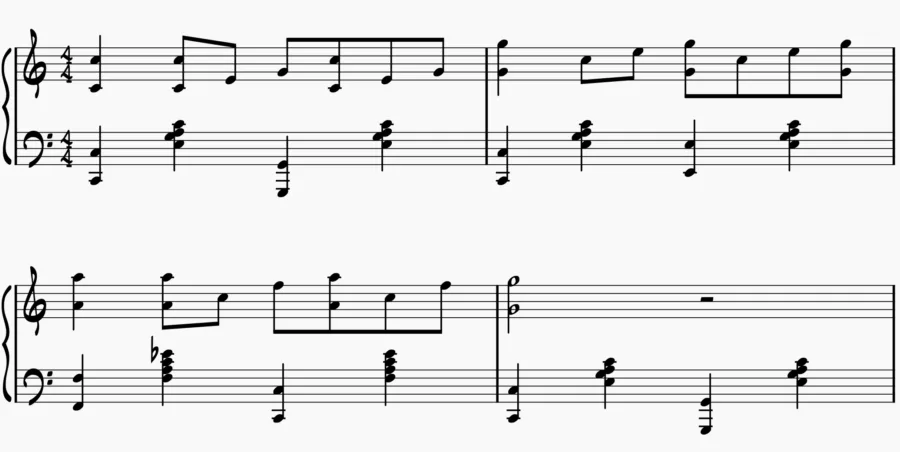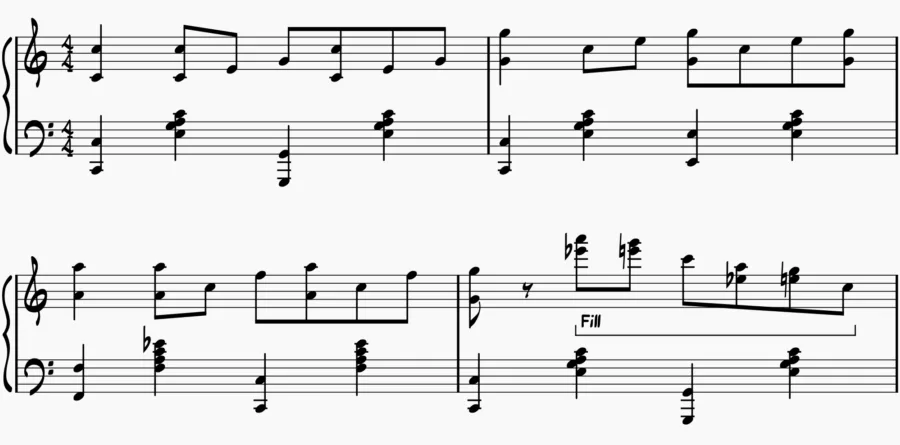One of the most common questions I hear from beginning piano students is "can I learn to play Maple Leaf Rag?" Or, "Is The Entertainer approachable as a beginner?" Ragtime and stride piano are some of the most popular old-time piano styles. They are a lot of fun to play, and can really impress your friends.
So, is ragtime hard to play? Ragtime is too hard for complete beginners, but is approachable by those who have been playing piano seriously for at least 2-3 years. Ragtime requires you to have a strong sense of rhythm and some technical proficiency to play it well.
Composed ragtime, like the rags of Scott Joplin, are a great first step for classically trained pianists. These compositions, like The Entertainer, Maple Leaf Rag or Solace are fully written and can be learned note for note from the sheet music.
As ragtime evolved over time, particularly through live performances in clubs during the 1920/30’s, it become more improvisatory and virtuosic. This ultimately created a new style similar to Ragtime, called Stride. Stride piano is one of the most difficult styles to master, due to its sheer technical nature.
Here’s a performance of Jelly Roll Morton’s Fingerbreaker, a notoriously challenging rag.
Getting Started #
Here are some ragtime piano concepts, ranked from easiest to most difficult.
- Simplified arrangements of Scott Joplin rags.
- Original compositions by Scott Joplin.
- Creating your own ragtime arrangements of popular tunes.
- Introducing technical challenges inspired by Jelly Roll Morton and Fats Waller.
- Adding jazz influence and harmony as in the style of Art Tatum and Oscar Peterson.
Some of my favorite modern ragtime players are current YouTube personalities. Scott Bradlee, proprietor of Postmodern Jukebox is a fantastic ragtime and stride player. Additionally, I’d be remiss not to mention my own teacher, Jonny May, who spent many years as the ragtime player on Main St. inside Disneyland, CA.

Step-by-Step Video Training
As a premium member of Jazz-Library you will have access to our Jazz Fundamentals video course which has 70+ video lessons teaching you comping rhythms, chord voicings, soloing strategies and more.
The Style of Ragtime #
Ragtime piano has a very distinctive “old time saloon” sound which is defined by some key characteristics:
- Stride left hand patterns
- Syncopated, accented melody lines
- Arpeggiated filler patterns
- Flashy fills and chromatic lines
- Harmonically simple chord changes, especially compared to jazz.
- Straight (even) 8th notes.
For a casual piano player, none of these are too difficult to learn, but can be harder to combine together fluently. Let’s each about each of these individually first, and then we’ll discuss some exercises to put them together into a song.
Stride Left Hand Patterns #
Ragtime piano is defined first and foremost by the left hand stride pattern. In it’s most basic form, the player alternates bass notes on beats 1 & 3, with chords on 2 & 4. This is often called an “Oom Pah Bass,” as it emulates the rhythmic sounds of tubas and drums of contemporary marches of the time.
Single Note Bass
The easiest way to play a Ragtime stride left hand is by alternating single notes in the bass with chords. By keeping the bass notes and the chords close together, it eliminates the technical challenge of jumping the left hand too far.

As you get comfortable, you’ll want to introduce that jumping technique by dropping the single notes down an octave.

Octave Bass Notes
The next step in building your left hand stride is to double the single bass notes in octaves. This gives the root a stronger presence, and an overall thicker sound.

Alternate root / 5th
Playing only root notes in the bass can sound pretty monotonous after a few bars. To alleviate that, alternate between the root on beat 1 and the 5th on beat 3.

When a single chord lasts for more than a single bar, feel free to experiment with other chord tones in the bass too. Try a walk up, using all the chord tones, for some variety.

10ths in the Bass
Octaves in the bass are fine, but if you are feeling extra ambitious, try upgrading those octaves to 10ths. This can be a challenge, especially for those with small hands.

If you can’t reach a 10th comfortably, then try rolling them.
Chromatic Leading Tones in the Bass
When you are moving from one chord to another, you can anticipate the change by playing a chromatic leading tone in the bass. In this case, moving from the I chord to the IV we insert a leading tone beneath the new chord.

This creates a pulling effect from one chord to the next, which helps smooth out the changes.
Syncopated Melody Lines #
When playing a song in ragtime you must...MUST... syncopate the melody. Don't be afraid to change the melody to work in the syncopation. It can be a little hard to do at first, but once you get the style in your ears, it comes pretty naturally.
Lets take the traditional children’s tune Twinkle, Twinkle, Little Staras an example. Here's how the originally melody sounds, all boring and straight:

Before we syncopate it, lets make one more small change. Lets double the melody in octaves. This will open up the chance for us to add arpeggiated fillers in the next section.

Okay, now lets syncopate! Notice how some notes fall on the beat, and some fall off the beat. That's important to get the effect. It needs to sound a little wobbly, as if you were pushing a cart with an egg shaped wheel.

Arpeggiated Fillers #
Ragtime is supposed to sound busy — chocked full of notes! That’s part of what makes it so impressive to listen to. Lets fill in some of the blank space in our arrangement with notes from the chord.

Roughly speaking, I'm filling in the gaps with little segments of arpeggios from the current chord. The trick is to keep those 8th notes going steady, while accenting the melody line with octaves.
There are a bunch of standardized ragtime patterns for your right hand. I highly encourage you to listen carefully for them, and take note of them in your sheet music.
Lets combine our new syncopated right hand with the oom-pah bass in our left hand! This is a bit difficult to do. Go slow, look where the hands line up, and build up the speed as you get comfortable.

Flashy Fills and Runs #
When there are long silent breaks in our right hand, it's our time to shine! Our job is to fill them up the silent with flashy riffs and fills which add excitement.
These fills are a topic all of their own. I've stolen a bunch from Jelly Roll Morton and Zez Confrey that Ive put in my bag of tricks over the years. I encourage you to do the same.
As just one example, here's a classic enclosure pattern that's really fun to play:

Harmonic Structure #
Ragtime music usually has rather simple harmonic structures, especially compared to more sophisticated jazz harmonies. Notice how our arrangement of Twinkle, Twinkle, Little Starsounds fun and jazzy, even though we've only used 2 chords. When you fill up the space with arpeggiated fillers and flashy runs, you don't need fast chord changes to create excitement. (Someone forgot to tell this to Art Tatum or Oscar Peterson...)
The chords also tend to be diatonic to the key of the song, with the occasional secondary dominant. We don't hear much "outside" harmony in Ragtime. Chords also change at a reasonable pace, only every bar or two.
Straight 8th Notes #
A lot of beginning ragtime players make the mistake of playing ragtime with a swing feel. Stride was born in the era of marches, and nothing is more rhythmically strict than a march.
Swing music didn’t really become mainstream until the 1930’s, after the surge of ragtime popularity in the 20’s. As Ragtime evolved into Stride music around that time, players started introducing a swing feel into their playing.
While there’s no hard and fast rule, most players I know consider Ragtime to be in straight time and Stride to be be either straight or swung.
Tempo - Not too fast! #
Ragtime is high energy, and all too often ragtime pianists equate high energy with a fast tempo. But I think if you listen to a lot of ragtime music, you’ll realize it’s not really as fast as it sounds.
Ragtime was heavily influenced by John Philip Sousa’s marches, which were around 120bpm — walking speed. While your ragtime playing is full of fast notes, we shouldn’t speed up the overall tempo too much. That leads to sloppy playing, technical inaccuracy, which makes you sound amateurish.
Ragtime should be controlled as if to give the illusion it’s not hard to play. People should remark “Wow, they make that look so easy!” Stay in control, not too fast.
Scott Joplin’s notes on the topic have become pretty famous in their own right. At the top of his sheet music for Maple Leaf Rag he’s written “NOT TOO FAST!” Oh, how many piano players have ignored this direction! And while Joplin played it unusually slow compared to modern recordings, his point still stands. Not too fast. Stay in control.
Putting it All Together #
One of the hardest aspects of learning to play ragtime piano is how to make the right and left hands act independently. The left hand is jumping around in a straight rhythm, while your right hand is also jumping around, but in a syncopated pattern.
This can be extremely intimidating — and frustrating — when first learning to play ragtime. Your hands just won’t know how to work together intuitively. Don’t worry, we’ll break it down into some ways to make it easier.
Building Hand Independence #
Ironically, the trick to making your hands work independently is to figure out how they work together. You want to build strong muscle memory in your left hand stride, and your right hand patterns. You won't be able to play fast until these are really comfortable in your hands.
Step by step, here's how to make this as easy as possible:
Before you even sit down to play, take a look at the music. Make notes where the right hand and left hand play together rhythmically. I like to draw vertical lines to connect them.
Take only a few measures and play them one note at a time. Don't worry about being in rhythm yet, just make sure you play the hands together at the right time.
Introduce a metronome at a slow tempo. SLOW! Like 40 bpm, or even less. Do those few bars on repeat until you feel super comfortable. Do not tolerate mistakes in playing the hands together at the right times. Bad habits are really hard to undo, so get it right the first time. Trust me on this, I learned it the hard way.
Start bumping up the metronome, 10 bpm at a time. Keep going until you reach your desired tempo. Most ragtime is around 120 bpm but some faster rags can go as high as 160!
Repeat these steps for the rest of the song.
You'll find that once you've mastered passages with the common ragtime patterns that the remaining passages will come much easier. Ragtime sounds hard to play, but muscle memory makes it much easier.
Ragtime Songs That Aren’t Too Hard #
The Easy Winners - Scott Joplin
Elite Syncopations - Scott Joplin
The Entertainer - Scott Joplin
Pineapple Rag - Scott Joplin
Dizzy Fingers - Zez Confrey
If you enjoy playing those tunes, you are just getting started. One of the most fun things to do is to “ragify” non-ragtime tunes:
Hey Jude - Scott Bradley
Mario Themes - Scott Bradley
You’ve Got A Friend In Me - Kristen Mosca
One you’ve really gotten a handle on those, here are a few ragtime songs that are so hard they’ll make you cry.
Tea for Two - Art Tatum
Tiger Rag - Art Tatum
Kitten on the Keys - Zez Confrey
The Finger Breaker - Jelly Roll Morton
Ragtime can be a bit intimidating and difficult, but it's so much fun to play. It so much fun, it doesn't even feel like practice!
